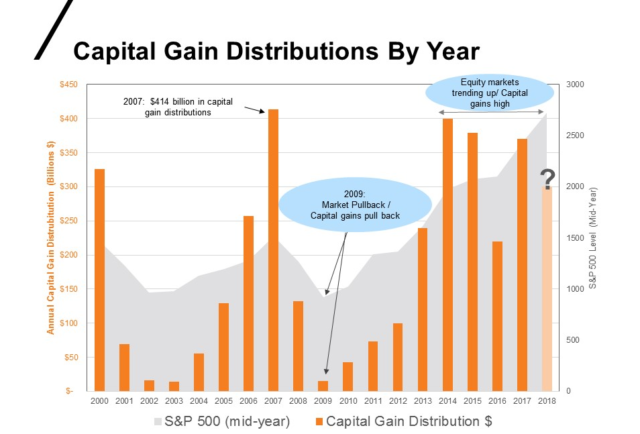2018 capital gain distributions: Won't get fooled again
I'm pretty sure Pete Townshend was thinking about the repeating headwinds capital gains cause each year when he penned "Won't Get Fooled Again" back in 1971.
Capital gain distributions are something that investors often don't pay attention to until late in the fourth quarter. But several events are coming to together to make the tracking and monitoring of capital gain distributions a year-round exercise. Each fiscal year, mutual funds add up the total of the recognized capital gains and capital losses for the fiscal year. If the gains are greater than the losses, a distribution is passed to investors as of the date of record. This distribution is typically made in December. According to the Investment Company Institute (ICI), 65% of mutual funds paid a capital gains distribution in 2017. The percentage is likely to be similar or even higher in 2018. If the number is so high, why do so many advisors and investors continue to get fooled? Why do so many fail to pay attention to mutual funds capital gains?
Four reasons why advisors need to monitor capital gains all year -- not just at year-end
1. ) Sustained up markets/increased distributions
The good news is that markets are up. The bad news is that capital gain distributions have been high. According to the S&P 500®, U.S. equity markets are on pace for a 10th consecutive year of positive returns. These sustained positive returns increase the likelihood that more mutual funds will recognize capital gains. But with a lack of market pullbacks or a down year, funds that are not tax-managed--or explicitly about tax-smart investing--have had little chance to create capital losses that can be used to offset these gains. The exhibit below shows the total amount of capital gain distributions for mutual funds as reported by the ICI, graphed against U.S. stock performance.

Index returns represent past performance, are not a guarantee of future performance, and are not indicative of any specific investment. Capital Gains: 2018 ICI Factbook, S&P 500®: Yahoo Finance, S&P 500® Index level represents first trading day in July for each year. Data as of August 2018.
2.) Intra-year distributions
Given this capital gain challenge, many mutual funds are making distributions mid-year to soften the total amount that is paid out in December. The total amount is still material, but the amount that is noticed and reported in December is reduced by any amount of payments made during the year. And it's not always easy to see or fully appreciate distributions made before year-end. If the investor is reinvesting dividends and capital gain distributions, they may not realize they received the mid-year taxable distributions--or any distribution--until they receive their 1099, after the fact.
3.) Funds facing selling pressure
Many active funds have been losing assets at the expense of passive alternatives1. This is especially true for U.S. equities. This selling pressure, plus the strong returns, are causing many funds to have increased capital gain distributions. And if your client owns a fund that had a large distribution in prior years, it does not mean they are in the clear. Continued selling pressure, up markets or unplanned turnover may trigger future distributions.
4.) Manager changes or mandate change
The management or the mandate of a mutual fund is not forever. Additionally, many funds are sub-advised by outside, third-party managers. Anytime a fund changes portfolio managers or subadvisors change, they often have different views and investing philosophies. Implementing these different views can lead to increased turnover. As the new manager sells the old and creates a portfolio that aligns with their preferred line-up, this turnover can cause material capital gains. Other changes that can impact the turnover within a fund include changes to its benchmark or a mandate change. Sure, these changes are communicated to shareholders, but these are easy to miss and can be difficult to fully understand. Mutual funds typically post their estimated capital gains during the fourth quarter. But these estimates are not always easy to find on fund companies' websites and can be very time consuming to find--especially if one must research multiple fund families.
Potential opportunity: Create scale and efficiency for taxable accounts
Hopefully you agree that focusing on after-tax returns and working to minimize the performance headwind caused by taxes can make a meaningful difference in successful investment outcomes. But trying to follow and complete adequate due diligence across multiple fund families can be a time-consuming process. So what's an advisor to do? Tax-managed equity funds may offer a compelling way to create leverage and scale in managing the tax headwind. We recommend a laser focus on funds and strategists with expertise around tax-smart investing. That may mean choosing funds that are tax-managed by name, where tax efficiency is referred to in the investments objective. We also recommend choosing funds that apply the following strategies:- They look for opportunities to harvest losses every trading day and not just at year-end.
- They feature more than one sub-advisor within a fund to help mitigate the impact of manager changes and reduce single manager risk. And when the inevitable manager or sub-advisor change does happen, they execute the manager transition with an eye on minimizing tax impacts.
- They use new cash flows to establish higher cost basis for securities that are being considered for future sale.
- They post estimated capital gain distributions every single month for easy analysis by investors.